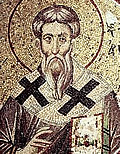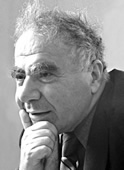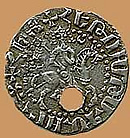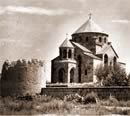Glossary (Gregory Narekatsi – Hripsime)
Gregory Narekatsi
 Gregory Narekatsi, pictured on an ancient manuscript
Gregory Narekatsi, pictured on an ancient manuscript
(951-1003) Great Armenian poet and theologian, author of religious hymns and poems. His Book of Sorrowful Songs also called Narek is very popular in Armenia and often used as a prayer book.
Gregory the Good
(Grigor Hamam) Armenian prince of Aghuank, who extended his influence far beyond Artsakh and Outik provinces. In 885, he proclaimed himself King of Aghuank. In 897, he redeemed the Armenian Catholicos Gevork imprisoned by the Arabs. His son Adrnerseh was proclaimed King of Shake, city in the far east of Aghuank proper.
Gregory the Illuminator
 The 14th century icon of Gregory the Illuminator(240-332) Spreader of Christianity in Armenia and founder of the Armenian Church. Offspring of a noble Armenian family, he was brought up as a Christian in Caesaria in Cappadocia. After he arrived in Armenia, he was imprisoned by Tiridates III and thrown into a pit where he spent 13 years. He survived, and then in 300, he converted Tiridates, who then imposed Christianity as a sole religion in Armenia making it the first Christian State in the world.
The 14th century icon of Gregory the Illuminator(240-332) Spreader of Christianity in Armenia and founder of the Armenian Church. Offspring of a noble Armenian family, he was brought up as a Christian in Caesaria in Cappadocia. After he arrived in Armenia, he was imprisoned by Tiridates III and thrown into a pit where he spent 13 years. He survived, and then in 300, he converted Tiridates, who then imposed Christianity as a sole religion in Armenia making it the first Christian State in the world.
According to Agathangheghos, Gregory was son of a Parthian named Anak, who had murdered King Khosrov of Armenia, by order of Ardashir I, founder of Sassanid dynasty. Tiridates, son of Khosrov, escaped. He then persecuted Gregory. Later, seized with an incurable illness, he was told to release Gregory. The latter then converted Tiridates and the whole of Armenia.
Grigor Zohrab
 Grigor Zohrab
Grigor Zohrab
(1861-1915) Influential Armenian writer, journalist, lawyer and political figure. From 1908, he was a member of the Ottoman parliament until he was arrested and killed in 1915.
Gtish
(Ktish, Gtchavank) Fortress on Toghasar mountain, in Dizak principality of Artsakh (Hadrout region of the NKR). Gtich was residence of princes of Dizak. In 853, the Prince Isaiah fortified it to resist the Arab commander Bugha. The monastery of Gtchavank was built here in 13th century.
Gulistan
Initially name of a village and fortress in the north of Artsakh, the name Gulistan extended in 15th century to the entire northern region of Artsakh. Later, Gulistan was one of the principalities of the so-called Country of Five (see Meliks of Karabakh). In the soviet times, Gulistan became Shaumian region.
Gugark
Historical province of the Greater Armenia, one of 15 worlds, Gugark consisted of 9 cantons: Dzorapor, Koghbapor, Tsobapor, Tashir, Tereghk, Kangark, Artahan, Javaghk, and Kgharjk.
Hadrout
Region of Nagorno-Karabakh Republic, approximately corresponding to the ancient Mius Aband and Dizak provinces of Artsakh.
Hayk
(Haik) Considered the forefather of the Armenian nation, Hayk is said to be direct descendant of the Biblical Noah. In ancient Armenia, he was deified and became supreme god in the Armenian pagan pantheon.
Hambartsumian, Victor
 Victor Hambartsumian(1908-1996) Prominent Armenian astrophysicist, author of several theories of star system origin and evolution. He was director of Burakan Observatory.
Victor Hambartsumian(1908-1996) Prominent Armenian astrophysicist, author of several theories of star system origin and evolution. He was director of Burakan Observatory.
Hetum I
 Silver coin of Hetum I
Silver coin of Hetum I
King of the Cilician Armenian Kingdom (1226-1270) and founder of Hetumids dynasty. He pursued a policy of alliance and friendship with the leaders of Mongols.
Higher Armenia
(Bardzer Hayk) Historical province of the Greater Armenia, one of 15 worlds. Higher Armenia consisted of 9 cantons: Daranaghi, Ariuts, Mindzour, Ekeghyats, Mananaghi, Derjan, Sper, Shaghagomk and Karin.
Hnchakian Party
Armenian political party founded in Geneva, Switzerland in 1887. The Hnchakians adhered to a Marxist-socialist theory. They believed in the liberation of Armenia through means of education and establishment of the worldwide socialist order.
Hovhannes Draskhanakertsi
(John VI) (840(?) – 931) Catholicos of Armenia from 899 to 931 and illustrious historian. In his fundamental History of Armenia he covered the period from the origins of the Armenians to the 20s of the 10th century. Eyewitness of many important events, he described in details the reigns of Sembat I and Ashot Erkat.
Hovsep the Confessor
Catholicos of Armenia (444-454). He was disciple of St. Mesrop Mashtotz. Hovseb was imprisoned during the Avarayr battle in 451 and then taken to Persia where he was murdered in 454.
Hripsime
 The cathedral of St.Hripsime
The cathedral of St.Hripsime
Christian virgin nun who was beheaded by order of King Tiridates around 300. The Armenian Church elevated her into sainthood. In the early 7-th century, the cathedral of the Virgin Martyr St.Hripsime was built in Vagharshapat (Echmiadzin).







